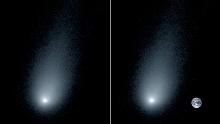It looks like you're using an Ad Blocker.
Please white-list or disable AboveTopSecret.com in your ad-blocking tool.
Thank you.
Some features of ATS will be disabled while you continue to use an ad-blocker.
24
share:

(CNN) Astronomers have captured the best and closest image to date of interstellar comet 2I/Borisov, a visitor that originated from outside of our solar system and is currently passing through.
This is only the second interstellar object to cross into our solar system after 'Oumuamua in 2017.
Astronomers at Yale University used the W.M. Keck Observatory's Low-Resolution Imaging Spectrometer, located in Hawaii, to provide the closest look at the interstellar comet since it was first observed over the summer.
They also provided an image they created to show it relative to Earth.
The new photo reveals the comet's impressive tail, which extends for nearly 100,000 miles. That's 14 times the size of Earth, according to the researchers at Yale.
"It's humbling to realize how small Earth is next to this visitor from another solar system," said Pieter van Dokkum, a Yale astronomer.
On December 8, the comet will pass within 190 million miles of Earth on its closest approach before continuing on through our solar system. As it gets closer to Earth, the icy comet is shedding more gas and dust through its tail through evaporation.
www.cnn.com...
It will be interesting to see if more are observed passing thru the SOL System.
Orbital Path of Comet 2I/Borisov


This illustration shows the path of comet 21/Borisov through our Solar System. This visitor came from interstellar space along a hyperbolic trajectory. It is only the second known intruder to zoom through our Solar System (the interstellar object ‘Oumuamua was detected in 2017).
As the graphic shows, the comet’s straight path across interstellar space is slightly deflected by the gravitational pull of our Sun. The comet is travelling so fast, at over 155 000 kilometres per hour, it will eventually leave the Solar System.
The panel on the right shows the comet’s position relative to Earth when the NASA/ESA Hubble Space Telescope observed it on 12 October 2019, when it was 420 million kilometres from Earth.
Credit:
NASA, ESA, J. Olmsted, F. Summers (STScI).
Impressive!
Will it be visible by naked eye?
In case that is not an English saying: without binoculars or telescopes.
Will it be visible by naked eye?
In case that is not an English saying: without binoculars or telescopes.
originally posted by: Blue Shift
"Let's shoot at it!" -- Humans
Would be interesting if we aimed a powerfully laser or beam at it sending signals it's direction and it changed directions or stopped.
Some may catch a glance on EA*RTH.
a reply to: Oleandra88
NASA Juno and MARS Reconnaissance Orbiter might be able to see it better
a reply to: Oleandra88
NASA Juno and MARS Reconnaissance Orbiter might be able to see it better
originally posted by: Ophiuchus 13
originally posted by: Blue Shift
"Let's shoot at it!" -- Humans
Would be interesting if we aimed a powerfully laser or beam at it sending signals it's direction and it changed directions or stopped.
Shooting a laser beam might actually deflect it as it boils off and expels material to push along a slightly different flight path. And shooting a laser in space, well, that will keep it nice and coherent.
new topics
-
What is the white pill?
Philosophy and Metaphysics: 16 minutes ago -
Mike Pinder The Moody Blues R.I.P.
Music: 1 hours ago -
Putin, Russia and the Great Architects of the Universe
ATS Skunk Works: 4 hours ago -
A Warning to America: 25 Ways the US is Being Destroyed
New World Order: 8 hours ago
top topics
-
President BIDEN's FBI Raided Donald Trump's Florida Home for OBAMA-NORTH KOREA Documents.
Political Conspiracies: 14 hours ago, 31 flags -
A Warning to America: 25 Ways the US is Being Destroyed
New World Order: 8 hours ago, 14 flags -
Is AI Better Than the Hollywood Elite?
Movies: 15 hours ago, 4 flags -
Mike Pinder The Moody Blues R.I.P.
Music: 1 hours ago, 2 flags -
Maestro Benedetto
Literature: 15 hours ago, 1 flags -
Putin, Russia and the Great Architects of the Universe
ATS Skunk Works: 4 hours ago, 1 flags -
What is the white pill?
Philosophy and Metaphysics: 16 minutes ago, 1 flags
active topics
-
Meadows, Giuliani Among 11 Indicted in Arizona in Latest 2020 Election Subversion Case
Mainstream News • 17 • : network dude -
New whistleblower Jason Sands speaks on Twitter Spaces last night.
Aliens and UFOs • 69 • : Ophiuchus1 -
Putin, Russia and the Great Architects of the Universe
ATS Skunk Works • 16 • : CristianVictoria -
Alternate Electors vs Fake Electors - What is the Difference.
2024 Elections • 123 • : frogs453 -
Gaza Terrorists Attack US Humanitarian Pier During Construction
Middle East Issues • 61 • : FlyersFan -
Massachusetts Drag Queen Leads Young Kids in Free Palestine Chant
Social Issues and Civil Unrest • 17 • : ToneD -
Hate makes for strange bedfellows
US Political Madness • 51 • : network dude -
The Acronym Game .. Pt.3
General Chit Chat • 7755 • : F2d5thCavv2 -
What is the white pill?
Philosophy and Metaphysics • 0 • : kwaka -
Democrats Introduce Bill That Will Take Away Donald Trumps Secret Service Protection
2024 Elections • 75 • : TzarChasm
24
